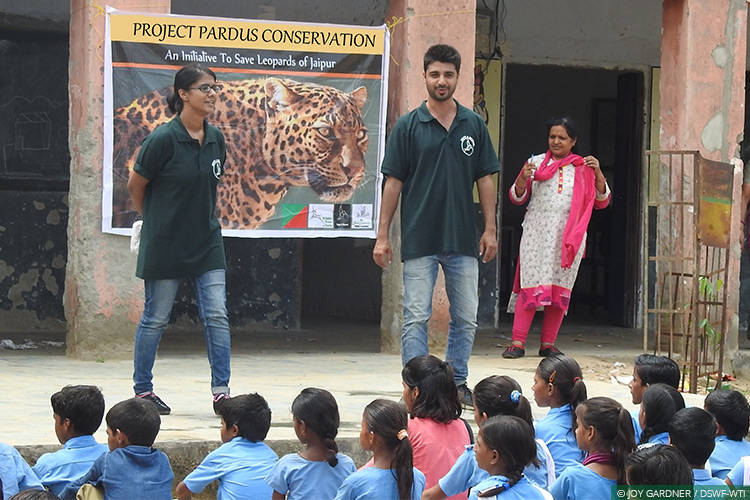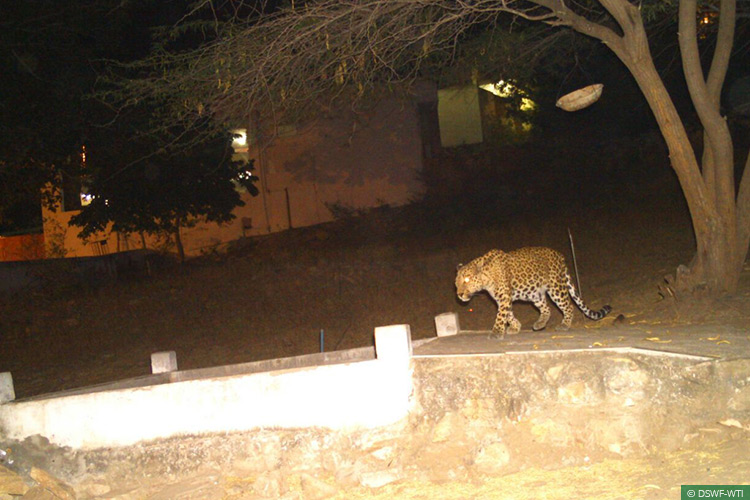RAP Addresses Human-Leopard Conflict and Fall in Leopard Numbers in Rajasthan’s Jaipur District
Jaipur, Rajasthan, January 30, 2017: Leopards occupy the highest trophic level in the forests of Rajasthan’s Jaipur district. The best stealth predators among India’s big cats, they are highly adaptable and particularly adept at living close to human habitations – which, given the increased degradation and encroachment of their forest homes by humans in recent years, they have had to be in order to survive.
An awareness event underway at a school in the Jaipur district as part of the project
In the Jaipur district though, their population has declined at alarming levels – by as much as 70-80 percent according to a study conducted by the Wildlife Institute of India in 2015. The primary cause: rising incidences of human-leopard conflict, including retaliatory killings by villagers that have lost cattle or kin in leopard attacks, and motor vehicle deaths on roads that cut through forested areas.
In July last year, Wildlife Trust of India initiated Project Pardus Conservation, a Rapid Action Project (RAP) conducted in partnership with Hope & Beyond and supported by the David Shepherd Wildlife Foundation, to address issues of conflict and the attendant fall in leopard numbers in the Nahargarh and Jhalana regions of Jaipur.
One of the primary aims of Project Pardus Conservation is to engage with affected communities and foster awareness about conflict mitigation techniques and the leopard’s ecological importance.
The project team conducted a survey to identify critical conflict zones in and around the forests of Jaipur to begin with. Some 79 villages around the Jhalana Forest Division and Nahargarh Wildlife Sanctuary were surveyed, with 34 villages emerging as areas of high conflict. Primary Response Teams (PRTs) comprised of individuals called ‘Hope Troopers’, drawn from among the local communities, were formed in strategic locations to provide information about leopard attacks and illegal activities such as hunting, poaching, felling of trees etc to the forest department and the project team. Some twenty such troopers have been appointed thus far; they have already been helpful in some cases, including the poaching of a partridge and a wild hare, and instances of illegal grazing in Nahargarh Wildlife Sanctuary. Towards the end of December, in a leopard conflict situation in Nagorian village, the project team and Hope Troopers created safe passage for the leopard, sensitised the villagers of the need for its conservation, and helped file a case with the local forest police station so that a farmer whose cow had been killed would receive compensation. A 24×7 telephone helpline has also been set up to receive early intimations about emergency conflict situations. Two cases from the villages of Khurad and Kho Nagoria were reported through the helpline soon after it was launched last year.
As with any conservation initiative that deals with conflict between humans and wildlife, one of the project’s primary aims is to engage with affected communities and foster awareness about conflict mitigation techniques, the leopard’s social behaviour and ecological importance, and government policies and legal frameworks that protect the species. Awareness events have accordingly been conducted with the Rajasthan Forest Department’s support in 25 schools and 38 villages situated in and around high-conflict areas. A lecture on specific activities under the project, and wildlife conservation in general, was also delivered at the University of Rajasthan in September; Dr VB Mathur, Director of the Wildlife Institute of India released a poster of the project. Shri Rajkumar Rinwa, the Hon’ble Minister for Environment & Forests, Government of Rajasthan appreciated the work done by the project team during a Wildlife Week event in October. Further, a lecture on conflict management was delivered at the Forestry Training Institute in Jaipur earlier this month.
A leopard captured by one of the camera traps placed under the project in the Jhalana region of Rajasthan
Camera traps have been placed in select areas in the Jhalana region to assess leopard movement in conflict zones. Innovative techniques of conflict mitigation are also being field-tested; one such technique, called ‘I-cow’, is a low-cost attempt in which eyes are painted on the hindquarters of cattle to reduce incidences of predation by leopards.
The project team is now planning to conduct meetings with key stakeholders such as forest officials, civil defence teams, police officials etc to disseminate information about conflict mitigation techniques. A media workshop will also be organised to encourage responsible reportage of human-leopard conflict situations.










